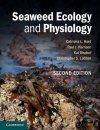By: Catriona L Hurd(Author), Paul J Harrison(Author), Kai Bischof(Author), Christopher S Lobban(Author)
551 pages, 216 b/w photos and b/w illustrations, 22 tables
![Seaweed Ecology and Physiology Seaweed Ecology and Physiology]()
Click to have a closer look
About this book
Contents
Customer reviews
Biography
Related titles
Recommended titles
About this book
In coastal seas, from the tropics to the poles, seaweeds supply the energy required to support diverse coastal marine life and provide habitat for invertebrates and fish. Retaining the highly successful approach and structure of the first edition, this is a synthesis of the role of seaweeds in underpinning the functioning of coastal ecosystems worldwide. It has been fully updated to cover the major developments of the past twenty years, including current research on the endosymbiotic origin of algae, molecular biology including 'omics', chemical ecology, invasive seaweeds, photobiology and stress physiology. In addition to exploring the processes by which seaweeds, as individuals and communities, interact with their biotic and abiotic environment, Seaweed Ecology and Physiology presents exciting new research on how seaweeds respond to local and global environmental change. It remains an invaluable resource for students and provides an entry into the scientific literature of a wide range of topics.
Contents
Preface
1. Seaweed thalli and cells
2. Life histories, reproduction and morphogenesis
3. Seaweed communities
4. Biotic interactions
5. Light and photosynthesis
6. Nutrients
7. Physico-chemical factors as environmental stressors in seaweed biology
8. Water motion
9. Pollution
10. Seaweed mariculture
References
Index
Customer Reviews
Biography
Catriona L. Hurd is an Associate Professor in the Institute for Marine and Antarctic Studies, University of Tasmania, Australia. She is known for her work on water motion, photosynthetic and nutrient physiology along environmental gradients in the intertidal and subtidal and, most recently, on ocean acidification.
Paul J. Harrison is Professor Emeritus in the Department of Earth and Ocean Sciences at the University of British Columbia, Vancouver, Canada. He is an expert in nutrient ecophysiology of seaweeds and phytoplankton, with over 40 years of research experience.
Kai Bischof is Head of the Department of Marine Botany at the University of Bremen, Germany. His research covers all aspects of seaweed ecophysiology, with a focus on the field of light acclimation and oxidative stress management.
Christopher S. Lobban is Professor of Biology in the Division of Natural Sciences at the University of Guam, Mangilao, USA. He has over 40 years of experience working with marine algae, including 25 years on coral reefs in Guam. He is currently investigating biodiversity of coral reef diatoms.



































